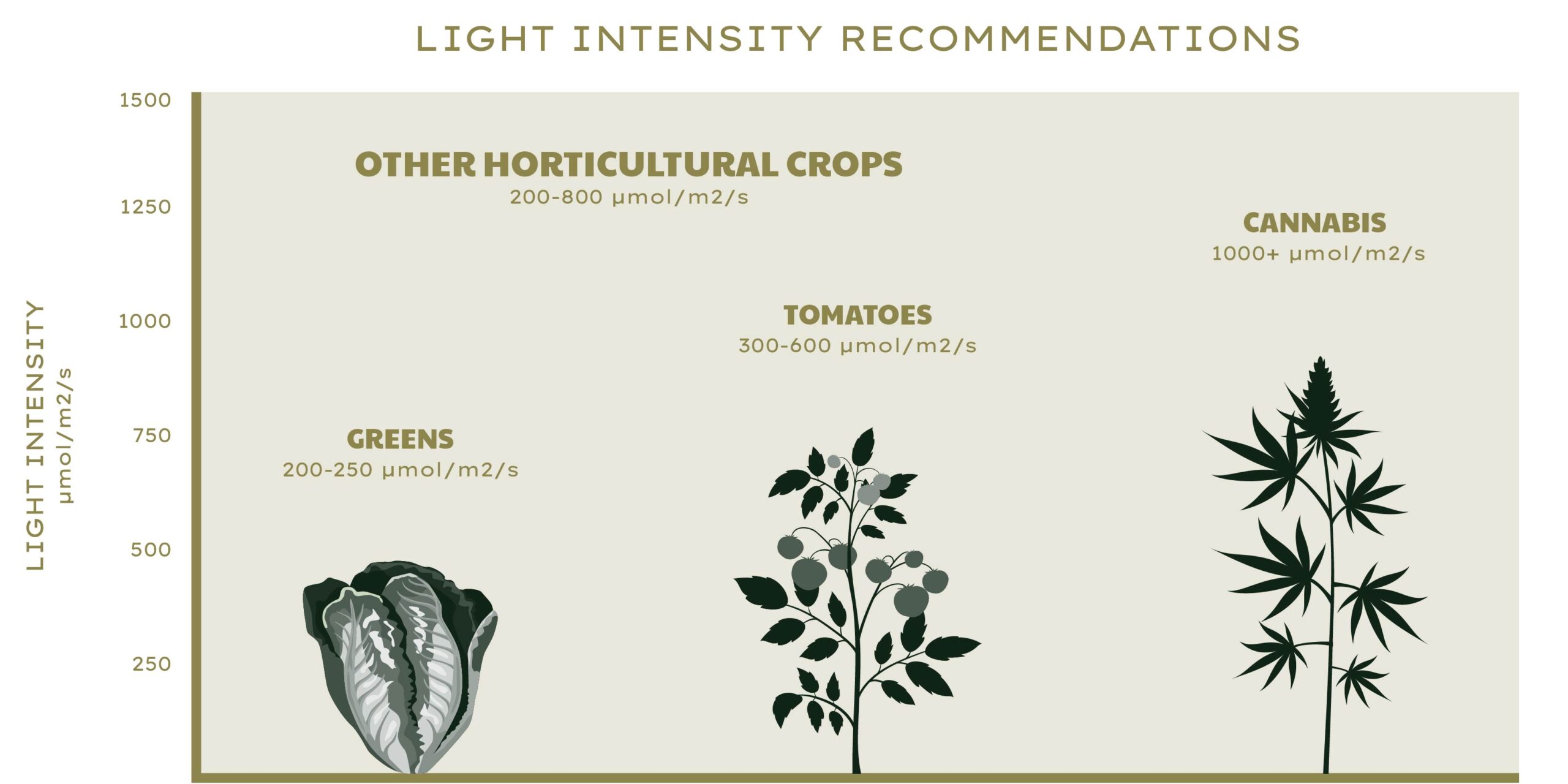Seasoned growers know that when crops are provided with the right environment and resources, the plants do most of the work. The main commercial production goals can be summed up with two crucial and interconnected metrics: yield and quality.
Since plants cannot move to find food or escape danger, they rely on complex biochemical processes, called metabolisms to survive. To maximize yields and quality, growers must know how these metabolisms are fueled and regulated so they can best be utilized.
This blog will provide a brief overview of how primary and secondary metabolisms affect yield and quality, and how growers can take advantage of these natural processes through the use of lighting, environmental controls, and pruning techniques.
What are the primary metabolisms?
The primary metabolisms, photosynthesis and respiration, are the processes by which plants capture, store and use solar energy. Plants can be viewed as solar-powered biochemical reactors. In the simplest terms, photosynthesis captures solar energy by reassembling water and carbon dioxide (CO2) into sugars, whereas respiration consumes those sugars to generate energy.
During photosynthesis, plants take in water, CO2 and sunlight, and produce sugar and oxygen. Photosynthesis occurs in two steps: the light- dependent reactions, and light-independent reactions.
Directing Energy flow with commercial automation equipment
The rates of photosynthesis and respiration vary throughout parts of the plant, the day, and life cycle of the plant. Understanding these variations allows growers to take advantage of plants’ natural metabolic machinery to meet production needs. Plant parts can be grouped into producers (sources) and consumers (sinks) of energy. Mature leaves photosynthesize more than they respire, meaning they produce more energy than they require. Conversely, actively growing parts, roots, fruit and flowers all require more energy than they produce.

At a commercial scale, the proper automation equipment is essential for balancing all growth factors. At RMJ, We automate, control, and provide sensors for Integrated Crop Steering, HVACD, CO2, Greenhouse, Irrigation, Fertigation, Water Treatment, Security, Labor Tracking, and Post Harvest Automation. For example, companies like IOGRU offer integrated controller technology systems to help you achieve the best growing conditions and maximize plant health.
How to use light to increase yields
Cannabis is a high light intensity crop but how do we know when we are providing the correct amount of light? For photosynthesis, plants use light wavelengths in the red and blue spectra, also called photosynthetically active radiation (PAR). Other light measures such as Lux or Lumens are measures of visible light, so are not directly applicable to horticultural lighting.
The light saturation point for cannabis has not yet been established so we can assume that more light is better. If all other growth factors are balanced, lights that deliver the highest PAR light intensity increase yields. It’s important to note that to produce a consistent, safe, medical-grade product, cannabis is frequently grown indoors under entirely artificial light. With this in mind, growers must wrestle with the fact that while more light produces a higher yield, more light also comes at a higher cost.

The use of quality lights to maximize both yields and efficiency is critical. Two of the most popular types of lights used in commercial cultivation are high-pressure sodium (HPS) lamps and light-emitting diodes (LEDs). HPS have been the preferred lighting source for decades because they are fairly efficient at converting electrical energy into PAR. However, HPS lights also generate a lot of heat which requires more cooling capacity and can be expensive to maintain.
On the other hand, LED technology has progressed quickly over the last 20 years. Currently, LED fixtures provide a variety of spectral profiles and are much more efficient than HPS. They also generate less heat than HPS requiring less cooling capacity. Your Lighting choice should aim to maximize both light intensity and efficiency. We recommend Phillip’s Horticultural Lighting Solutions because they offer a wide variety of LED grow light recipes, based on proven results for specific varieties, growth phases, and cultivation set-ups.
Improve flower quality boosting secondary metabolisms
While yield is an essential metric for producers, the overall biomass cannot be decoupled from flower quality. Most flower quality attributes such as density, smoke quality, and appearance are difficult to quantify, so quality is often measured as potency, or the concentration of cannabinoids and terpenes.
As the cannabis market matures, quality measures such as Total Active Cannabinoids (TAC) and terpene profiles are starting to be used to differentiate higher quality flower from those with only a high THC concentration. To increase the production of secondary metabolites, one must consider the role they play in the plant. While the evolutionary purpose of cannabinoids is still somewhat of a mystery, there are several hypotheses, all suggesting cannabinoids as defense chemicals.
Recent studies have shown environmental cues such as controlled drought stress, salt stress, and UV exposure increase yield and cannabinoid concentration. On the other hand, pruning and defoliation can increase yields and potency but it is important to keep sources when photosynthesis is needed and remove non-floral sinks when respiration in flowers is needed.
Conclusion
Burgeoning research into cannabis horticulture shows that deeper understanding of the complex regulation of secondary metabolites will provide many novel approaches to increase production of valuable secondary metabolites in the coming years. As with primary metabolisms, good environmental controls and high-quality lighting are essential to harnessing these secondary metabolisms.
Learn more about our automation and lighting offerings and contact us to get started with a proposal.
Want to dive deeper into harnessing plant metabolism for improved yield and quality?
